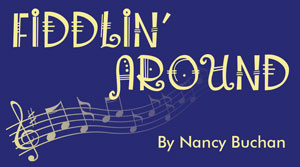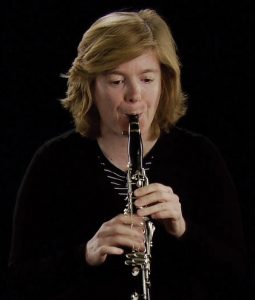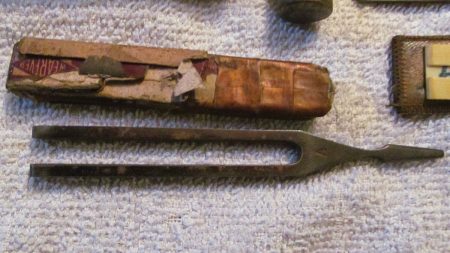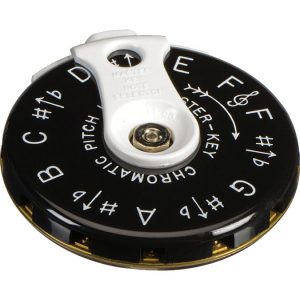Fiddlin’ Around – April 2018
 You can tune a guitar. You can play a tune on it. Some people can ‘carry’ a tune. Some people couldn’t sing in tune if their life depended on it. You can tune an instrument with ‘perfect pitch’ or with ‘relative pitch’. There are tuning forks and electronic tuners. What does it all mean?? Well, basically it’s all about adjusting an instrument to play a note which everyone has agreed upon. A pitch that is defined by the number of vibrations per second that are produced.
You can tune a guitar. You can play a tune on it. Some people can ‘carry’ a tune. Some people couldn’t sing in tune if their life depended on it. You can tune an instrument with ‘perfect pitch’ or with ‘relative pitch’. There are tuning forks and electronic tuners. What does it all mean?? Well, basically it’s all about adjusting an instrument to play a note which everyone has agreed upon. A pitch that is defined by the number of vibrations per second that are produced.  That’s what is meant when someone says they are tuning to standard A 440 Hz—they have adjusted the A note above middle C on their violin or their oboe or their harp to produce 440 cycles. But if you think it’s difficult to get a group of folks to agree on where to go for lunch, then imagine trying to get millions of musicians throughout history to agree on a common note to tune their instruments to. I’m not even going to mention Middle Eastern tuning, or Oriental, or Indian, or even Louisiana home-grown Cajun music!
That’s what is meant when someone says they are tuning to standard A 440 Hz—they have adjusted the A note above middle C on their violin or their oboe or their harp to produce 440 cycles. But if you think it’s difficult to get a group of folks to agree on where to go for lunch, then imagine trying to get millions of musicians throughout history to agree on a common note to tune their instruments to. I’m not even going to mention Middle Eastern tuning, or Oriental, or Indian, or even Louisiana home-grown Cajun music!
First I’m gonna talk about orchestras. There are four different designations within an orchestra. The String section, the largest of the four, includes the upright bass, (the lowest in pitch) cello, viola, and violin. Since the strings make up more than half of the total musicians in an orchestra, the violins are usually separated into first and second sections. The first section players generally deal with the slightly more important and difficult parts, and there could be as many as 15 violinists in each section.
 Then there are the Woodwinds—instruments that produce a sound by blowing into either double reeds, single reeds or sound holes. That includes the bassoon (the lowest pitch and which has two reeds), the oboe, clarinet, flute, and piccolo, and there are usually 2 to 4 of each of those instruments. The Brass section includes trumpets, French horns, trombones and tubas, and they are usually situated in the middle to the back of the orchestra as they are the loudest. The Percussion section is what you would expect—bells and kettle drums and cymbals and gongs and xylophones—things you bang on. There is less leeway for tuning many of the percussion instruments, so they lobby for certain tuning standards. All these different instruments have to get on the same page with tuning their various instruments, and of course they all think their specific concerns are the most important. That diva soprano wants the orchestra to be tuned a little lower so she can hit those high notes with authority. Another wrinkle in the tuning controversy is that many orchestras play with huge organs, which are likely to change in pitch due to weather or humidity, and they are much more difficult to alter. Having to tune to them can make for even more dissent. Some guitarists like tuning to a lower pitch so they don’t break strings as easily, and some guitarists like tuning to a higher pitch to compensate for the strings being stretched out during playing and going slightly lower. Conductors like the brightness of tone they get overall when the orchestra is tuned slightly higher, brass players dislike tuning higher as their instruments don’t resonate as well. Pianos can be permanently damaged by re-tuning them to a higher pitch, and composers want to impose their opinion on the people performing their creations. It’s amazing anything ever gets musically accomplished!
Then there are the Woodwinds—instruments that produce a sound by blowing into either double reeds, single reeds or sound holes. That includes the bassoon (the lowest pitch and which has two reeds), the oboe, clarinet, flute, and piccolo, and there are usually 2 to 4 of each of those instruments. The Brass section includes trumpets, French horns, trombones and tubas, and they are usually situated in the middle to the back of the orchestra as they are the loudest. The Percussion section is what you would expect—bells and kettle drums and cymbals and gongs and xylophones—things you bang on. There is less leeway for tuning many of the percussion instruments, so they lobby for certain tuning standards. All these different instruments have to get on the same page with tuning their various instruments, and of course they all think their specific concerns are the most important. That diva soprano wants the orchestra to be tuned a little lower so she can hit those high notes with authority. Another wrinkle in the tuning controversy is that many orchestras play with huge organs, which are likely to change in pitch due to weather or humidity, and they are much more difficult to alter. Having to tune to them can make for even more dissent. Some guitarists like tuning to a lower pitch so they don’t break strings as easily, and some guitarists like tuning to a higher pitch to compensate for the strings being stretched out during playing and going slightly lower. Conductors like the brightness of tone they get overall when the orchestra is tuned slightly higher, brass players dislike tuning higher as their instruments don’t resonate as well. Pianos can be permanently damaged by re-tuning them to a higher pitch, and composers want to impose their opinion on the people performing their creations. It’s amazing anything ever gets musically accomplished!
What usually happens to get the concert started, is that the head oboe player will tune his instrument to an electronic tuner (they used to use a tuning fork) backstage, then he will stand in front of the orchestra and play the note that corresponds to 440 A. Oboes are used because they keep the same pitch easily and don’t slide around much. The oboe player will then give the same note to the 1st chair violinist (or concertmaster) who will in turn play the note for the whole orchestra to tune to. The string players, and there could be 50 of them, all get the same 20 or so seconds to tune their four strings, so they better be able to focus in all the noisy chaos and be good and fast at it. Most string players learn early on to tune their A string first, then play it with the other strings, listening to the relative pitch and adjusting it to whatever interval you need. For example, a viola has 4 strings, one of which is the A string. All the other strings are tuned in fifths, an interval which is fairly easy to train yourself to hear as the strings are all 5 notes apart. A guitar is tuned in fourths, except for the third string, which is tuned to a third—guitarists will often use the visual of the frets to get themselves in tune.
 In 1859 the French government passed a law that decreed the A note above middle C to be set at 435 Hz. This was the first attempt to standardize pitch on a large scale and was called the ‘diapason normal’. So called ‘scientific pitch’ sets the A at 430.54 Hz, and today many orchestras decide themselves what method they are going to use. The Boston Symphony tunes to 444 Hz, the NY Philharmonic to 443 Hz, the Berlin Philharmonic to 445 Hz….and frankly there is some artistic defiance involved. Everyone has their own opinion, depending on how their particular instrument responds to tuning, and sometimes the overall sound on a recording is raised or lowered electronically—a kind of snooty and lazy way to keep folks from trying to play along, and a practice which just feeds the debate.
In 1859 the French government passed a law that decreed the A note above middle C to be set at 435 Hz. This was the first attempt to standardize pitch on a large scale and was called the ‘diapason normal’. So called ‘scientific pitch’ sets the A at 430.54 Hz, and today many orchestras decide themselves what method they are going to use. The Boston Symphony tunes to 444 Hz, the NY Philharmonic to 443 Hz, the Berlin Philharmonic to 445 Hz….and frankly there is some artistic defiance involved. Everyone has their own opinion, depending on how their particular instrument responds to tuning, and sometimes the overall sound on a recording is raised or lowered electronically—a kind of snooty and lazy way to keep folks from trying to play along, and a practice which just feeds the debate.
As for more modern ensembles and music styles, the pitch pipe or tuning fork has been replaced by electronic tuners, devices which can be very sophisticated and exact or can be cheap and merely functional. It is still absolutely necessary to learn how to tune your own instrument, no matter what the exact method or source of the note you tune to is, and it is necessary to recognize when you are singing or playing out of tune. Tuners have made it easier to be accurate in a noisy bar or if you need to change a string real fast, but there is no real excuse for allowing yourself to play or sing out of tune. Practicing the skill of recognizing and adjusting to a specific note is the only answer.
 440 A was established in the States in the 1950s by the International Standards Organization, even though most of the centuries old compositions were apparently meant to be played by using 432 Hz as their tuning. Apparently they have found tuning forks used during those eras. Many musicologists believe that music would generate more positive healing energy if A was tuned to 432, and they support this view by citing scientist, mathematician and philosopher Pythagoras, who talked about “the music of the spheres”. He claimed that mathematical intervals or ratios of the number 432 are found in the distance and sizes of the planets, the sun, the moon, the equinoxes, the Great Pyramid of Egypt, Stonehenge and other sacred sites. Conspiracy theorists will tell you that the promotion of 440 tuning was done by either the Nazis, the Catholics, or even the Rockefellers, as part of a heinous plan to warp the consciousness of the masses. They also claim that the music industry imposed this frequency on us to ‘herd’ people into greater aggression, social agitation and emotional distress. Who knows—they might be right. Tibetan monks’ hand-made tuning bowls are tuned to 432, and many people, when exposed to the same piece at the two different tunings find the lower 432 tuning to be more peaceful and pleasant to listen to.
440 A was established in the States in the 1950s by the International Standards Organization, even though most of the centuries old compositions were apparently meant to be played by using 432 Hz as their tuning. Apparently they have found tuning forks used during those eras. Many musicologists believe that music would generate more positive healing energy if A was tuned to 432, and they support this view by citing scientist, mathematician and philosopher Pythagoras, who talked about “the music of the spheres”. He claimed that mathematical intervals or ratios of the number 432 are found in the distance and sizes of the planets, the sun, the moon, the equinoxes, the Great Pyramid of Egypt, Stonehenge and other sacred sites. Conspiracy theorists will tell you that the promotion of 440 tuning was done by either the Nazis, the Catholics, or even the Rockefellers, as part of a heinous plan to warp the consciousness of the masses. They also claim that the music industry imposed this frequency on us to ‘herd’ people into greater aggression, social agitation and emotional distress. Who knows—they might be right. Tibetan monks’ hand-made tuning bowls are tuned to 432, and many people, when exposed to the same piece at the two different tunings find the lower 432 tuning to be more peaceful and pleasant to listen to.
While the argument of what note or frequency to tune to goes on, check out the live music going on around our beautiful little part of the planet. Dos Locos in Quepos has live music on Wednesday nights with Ben Jammin’ and the Howlers, and Saturday afternoons with different, more acoustic flavored folks, including Ralph Simms and myself. Roca Verde, in Dominical, hosts the G String Cowboys on Thursday nights and the Howlers every Friday night. Tortilla Flats, on the beach, sporadically has live music, as does The Rum Bar, Fuego and Rio Lindo. Farther south in Ojochal there’s the Bamboo Room, with everything from blues to ZZ Top impersonators. And no, a guy with a computer and who is manipulating pre-recorded or electronically produced music is not LIVE music. That is called a DJ, and there are some good ones around here with great equipment and good intentions.
Harpists spend 90% of their lives tuning their harps and 10% playing out of tune.
Composer Igor Stravinsky
Oh my luv is like a red, red rose that’s newly sprung in June—Oh my luv is like the melodie, that’s sweetly play’d in tune.
Poet Robert Burns
I learned to tune a guitar by ear. That method has served me pretty well.
Country artist Charley Pride
